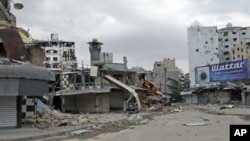Editors note: VOA's Elizabeth Arrott got a rare glimpse for a foreign reporter of the residue of fighting in Syria. This is her report:
U.N. observers on Thursday toured the battered flashpoint Syrian cities of Homs and Hama, and found that more than a year of fighting between the government and its opponents has taken not just a physical, but also a profound psychological toll.
Touring the streets marked by burnt-out buildings, Robert Mood, the head of the U.N. mission in Syria, said seeing the suffering of the Syrian people moves him to help end the violence.
“They really deserve a chance and we still have a good chance, a good opportunity to break the growing cycle of violence, turn it around to a positive cycle,” he said.
Haunting remnants of continuing violence
While in Hama, a bastion of opposition to President Bashar al-Assad, the Norwegian general said his team is already having results trying to enforce a deteriorating cease-fire between government forces and rebels.
“What I've seen since I've arrived on the ground is that my observers, where they are, have a calming effect,” he said.
But Mood is the first to admit the monitors, now numbering several dozen, cannot be everywhere. And certainly not all the time.
Ali Qatlabi, an antiquities inspector in the hard-hit city, said sometimes there is nothing but gunfire at night.
The results of the fighting are evident in Hama and Homs: buildings with sandbags in every blasted-out window, security hunkered down in reinforced positions, stores shuttered.
Qatlabi spoke from a relatively quiet part of town as he enjoyed a brief moment of normalcy he wishes for all of Syria. But he couldn't say how or when that can be achieved. His advice in the meantime is simple. Everyone, he said, should stay at home.
That is not an option for some, as the burnt-out buildings in Hama and the encampments of the displaced, south of town, attest.
Surreal scenes of devastation
South of Hama lies the town of Ar Rastan, another center of anti-Assad opposition. Its northern edge sits atop a crest, an open field providing no defense to the homes there, each one blasted through by artillery.
In nearby Talbiese, another flashpoint, a government tank sits on the empty road into town.
On the outskirts of Homs, midday fighting blocks a road into town. An earlier view of the city showed the effects of one of the worst incidents of government pummeling of its enemies during the uprising.
In Homs, the streets are largely deserted. The few people on the streets move quickly, past walls blackened by explosions, and the painted-over graffiti of protesters. Patches of red wild poppies seem startling out of place in the bleakness of the scene.
During his tour of Hama, U.N. mission chief Mood said government forces had taken steps indicating a better willingness to live up to the peace plan.
A local school teacher, Nour, said she wishes “with all her heart” that life will get back to normal. But she said she is placing her faith in the hands of God.












